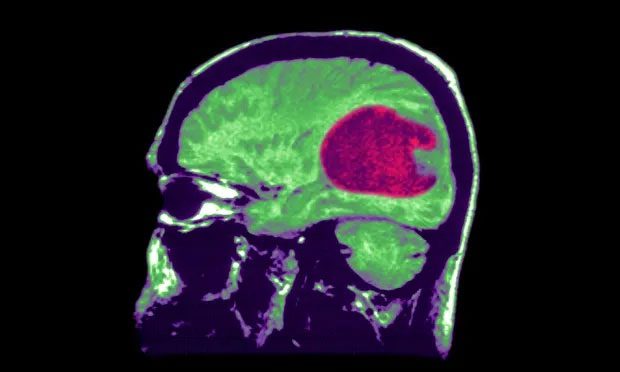According to a recent study published by Harvard Medical School, a new artificial intelligence (AI) tool could assist neurosurgeons in treating brain tumors.
The Guardian reported that for decades, neuroscientists have struggled to understand gliomas—primary tumors that originate from the brain’s glial cells, particularly common in cancer patients. This specific type of glioma is particularly dangerous and is also the cause of death for U.S. President Joe Biden’s son, Beau Biden, and Arizona Senator John McCain.

X-ray showing a glioma—the most common brain tumor in cancer patients. (Image: Getty Images)
Professor Kun-Hsing Yu from Harvard Medical School, who contributed to the research, stated: “Different types of gliomas require different surgical approaches.”
To safely remove a glioma without damaging surrounding brain tissue, neurosurgeons need extensive information that is often only available when the patient is on the operating table.
“When operating on a brain cancer patient, doctors will send a tissue sample to the pathology lab for immediate feedback. Here, an expert helps the surgeons determine whether they are cutting the correct tissue and what specific type of cancer the patient has,” explained Yu.
According to him, in modern medical facilities, an expert typically completes the analysis of a patient’s brain tissue within 10 to 15 minutes. This work is only done after the surgeons have opened the patient’s skull on the operating table. However, Yu noted that this process does not always go smoothly. Experts must maintain a high level of focus and prioritize analyzing samples from ongoing surgeries.
“Some individuals feel a lot of pressure, and the quality of the surgery can sometimes suffer. Thus, incorrect diagnoses can occasionally arise from this rapid process,” he said.
Professor Yu and his team discovered that machine learning (a branch of artificial intelligence where systems “learn” automatically from data to solve specific problems) could help analyze gliomas more quickly and accurately. This technology would reduce the surgery time for patients in the operating room.
Dr. Dan Cahill, a neurosurgeon at Massachusetts General Hospital, remarked that the accuracy of the new machine learning tool is impressive, certainly far superior to traditional molecular structure analysis techniques for gliomas. However, Cahill noted that the optimal surgical method may differ for each patient depending on the type of glioma.
Machine learning can suggest methods that doctors might use in treating brain cancer. One of the most reliable methods for treating gliomas is to inject tumor-killing drugs directly into the brain during surgery. Yu and his colleagues believe this technology could also help determine the extent of invasion of a specific tumor. From there, doctors can make quick and confident decisions about drug injections.
According to Yu, the technology in this new research is not ready for clinical use for several years. This tool still needs to receive approval from the U.S. Food and Drug Administration “to go green.”
However, Harvard Medical School’s research is not entirely novel. Previously, scientists in the UK have also viewed artificial intelligence as a tool to improve cancer treatment and detection.
Earlier this year, a group of medical researchers in London developed an AI tool that can determine whether abnormal tumors found on CT scans are cancerous.
Also in London, the software startup Kheiron Medical Technologies, co-founded by Hungarian computer scientist Peter Kecskemethy, has developed AI tools to assist radiologists in detecting breast cancer.
“We need AI to detect cancer, and this disease can also be treated using AI,” Kecskemethy stated.





















































